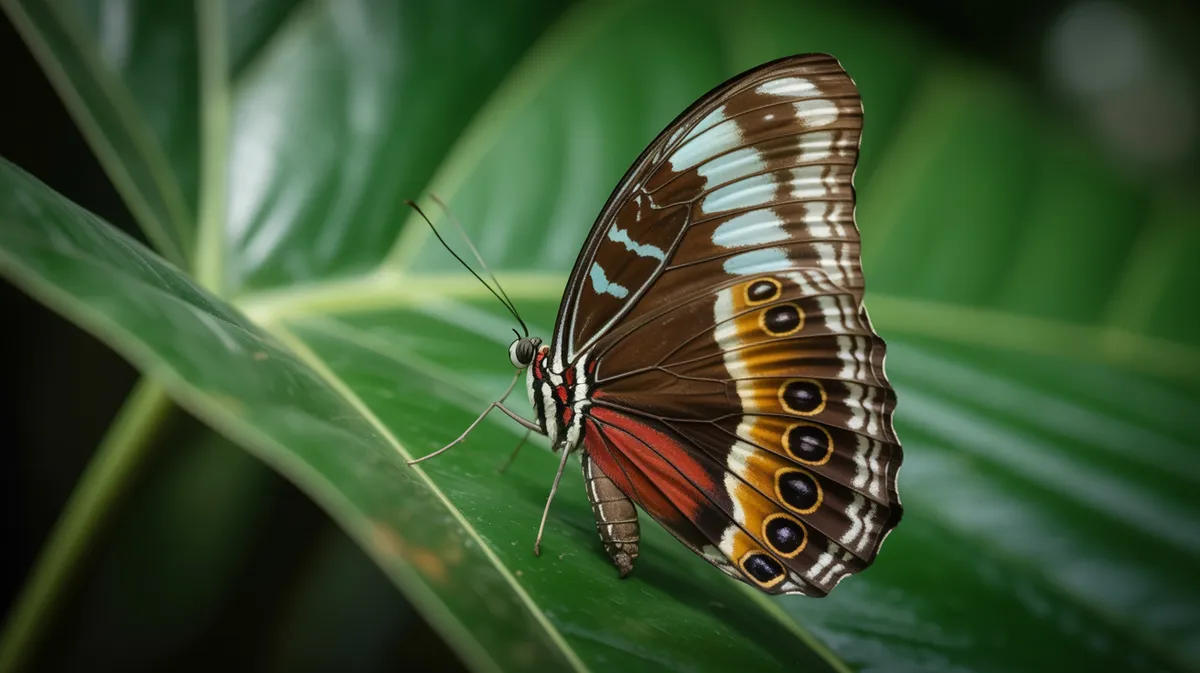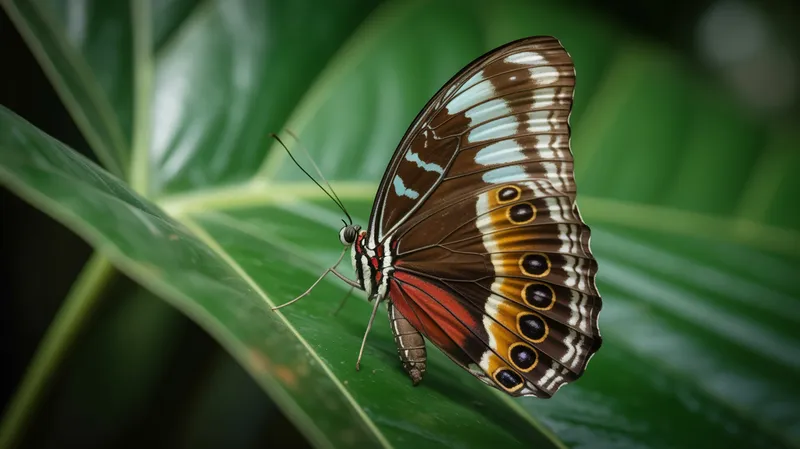
Shoemaker Butterfly
Catonephele orites

Meet the Shoemaker Butterfly
The Shoemaker Butterfly, scientifically known as Catonephele orites, is a striking species of butterfly found mainly in Central and South America. Characterized by its velvety black wings adorned with vivid orange bands or spots, it is named for the resemblance of these markings to the tools and patterns associated with shoemakers. Males and females display distinct color patterns, with males showing brighter orange spots. This butterfly is often seen in the lower levels of tropical rainforests, where it feeds primarily on rotting fruit and sap. Its elusive behavior and preference for dense forests make it a rare sight for casual observers.
Classification
Invertebrate
Habitat
Tropical rainforest
Diet
Herbivore
Lifespan
2-4 weeks (adult stage)
Conservation
Least Concern
Weight
0.17-0.25 grams
📖Fascinating Facts
Sexual Dimorphism
Male and female Shoemaker Butterflies have distinctly different wing patterns, with males displaying brighter and more pronounced orange spots.
Fruit Lovers
Unlike many butterflies that feed on nectar, Shoemaker Butterflies are attracted to rotting fruit and tree sap as their primary food sources.
Forest Dwellers
This species prefers the dense, humid understory of tropical rainforests, making it well-adapted to life away from open areas.
📋Detailed Description
The Shoemaker Butterfly (Catonephele orites) is a medium-sized nymphalid butterfly, with a wingspan ranging from 60 to 75 mm. Its dorsal wing surfaces are a deep velvety black, with males displaying prominent, iridescent orange patches on the forewings, while females exhibit more subdued, often bluish or white markings. The ventral side is mottled brown and gray, providing effective camouflage when the butterfly is at rest with wings closed. The body is robust and covered in fine scales, with clubbed antennae typical of the Nymphalidae family. Catonephele orites is primarily crepuscular, most active during early morning and late afternoon. It is solitary in nature, rarely forming aggregations except at feeding sites. This species is sexually dimorphic not only in coloration but also in behavior, with males being more territorial and females more cryptic. The larvae are spiny and green, mimicking the leaves of their host plants, while the pupae are angular and cryptic, resembling dried leaf fragments. Adults have a lifespan of approximately 2–3 weeks in the wild. Their elusive habits and preference for dense, shaded forest understory make them challenging to observe.
💡 Did you know?
Despite their vivid coloration, Shoemaker Butterflies spend much of their time in the shaded understory, making them difficult to spot in the wild.
🔬Research & Sources
🎭Behavior & Social Structure
Shoemaker Butterflies are primarily frugivorous, feeding on fermenting fruit, tree sap, and occasionally nectar, using their long proboscis to access fluids. Males are territorial, often patrolling small areas and engaging in aerial chases to ward off rivals. Both sexes exhibit mud-puddling behavior, seeking out moist soil or decaying organic matter to obtain essential minerals. Adults are generally solitary but may be observed in small numbers at abundant food sources. They are most active during periods of diffuse sunlight, avoiding the hottest part of the day. When threatened, they exhibit rapid, erratic flight patterns and often retreat to the shaded lower canopy. Roosting occurs on the undersides of leaves, where their cryptic ventral coloration provides camouflage from predators.
👶Reproduction & Life Cycle
Mating in Catonephele orites typically occurs during the early wet season, coinciding with increased fruit availability. Males attract females through pheromone release and visual displays, often perching on sunlit leaves to intercept passing females. Courtship involves short flights and antennal contact. Females lay single eggs on the undersides of host plant leaves, primarily from the Euphorbiaceae family. The egg stage lasts 5–7 days, followed by a larval period of 2–3 weeks, during which caterpillars undergo five instars. Pupation occurs on the host plant, with the pupal stage lasting 8–12 days. There is no parental care post-oviposition. Multiple generations may occur annually in favorable climates.
🛡️Adaptations & Survival
Catonephele orites exhibits several adaptations for survival in dense rainforest habitats. Its cryptic ventral wing coloration helps avoid detection by predators such as birds and lizards. The bright dorsal markings of males may serve as warning signals or for mate recognition. Larvae possess urticating spines that deter predators, and their green coloration provides camouflage among foliage. Adults have a rapid, erratic flight pattern, making them difficult to capture. Their ability to feed on a variety of fermenting fruits allows them to exploit a niche less utilized by nectar-feeding butterflies. Mud-puddling behavior aids in mineral uptake, crucial for reproduction.
📚Research Sources
🎨Cultural Significance
Although not widely featured in folklore, the Shoemaker Butterfly is appreciated by local communities and ecotourists for its striking appearance. Its name derives from the resemblance of the male's orange wing markings to traditional shoemaker's tools or patterns. In some regions, it is considered a symbol of forest health and biodiversity, and its presence is used as an indicator in ecological studies. There are no known traditional medicinal or utilitarian uses.
🔬Recent Research & Discoveries
Recent research has focused on the chemical composition of male pheromones and their role in mate selection, as well as the butterfly's role in nutrient cycling within rainforest ecosystems through frugivory and mud-puddling. Ongoing studies are examining the effects of habitat fragmentation on population genetics and dispersal. Molecular phylogenetic analyses have clarified its relationship to other Catonephele species, highlighting subtle differences in wing pattern genetics and larval host plant specialization. The species is also being monitored as part of broader biodiversity assessments in Neotropical forests.
🎥Wildlife Videos

The Secret And Fascinating Life Of A Butterfly | Real Wild
Elegant and graceful butterflies never cease to fascinate and impress, yet these amazing insects begin life as little worm-like ...
Real Wild

Monarch Butterfly Migration: A Mystery Of The Natural World - HD Documentary
Documentaries Zone

Butterflies: The Insects That Have 4 Magnificent Lives | Messenger of the Gods
From egg, to colorful food frenzy caterpillar, to encapsulation in a cocoon, butterflies are regarded at the summit of insect evolution ...
Real Wild

David Attenborough Presents: Hummingbirds - Jewelled Messengers | Free Documentary Nature
David Attenborough Presents: Hummingbirds - Jewelled Messengers | Nature Documentary Watch 'Birds of Passage - A Secret ...
Free Documentary - Nature

The Incredible Story of the Monarch Butterfly ★ Wildlife Documentaries HD
We always have to keep in mind that a Documentary, after all, can tell lies and it can tell lies because it lays claim to a form of ...
Wildlife Documentaries HD

The world of Butterflies - Full Documentary on Butterflies - Wildlife Documentary
The world of Butterflies - Fully Documentary on Butterflies - Wildlife Documentary.
Youtube Madness
🌍Habitat Information
The Shoemaker Butterfly typically inhabits Tropical rainforest environments. Shoemaker Butterflys have adapted to their environments with specialized features and behaviors.
Primary Habitat:
Tropical rainforest
More detailed habitat information will be available soon.
🛡️Conservation Status
The Shoemaker Butterfly is currently classified as Least Concern. Conservation efforts are crucial for preserving this species for future generations.
Common Threats:
- 🏠Habitat loss and fragmentation
- 🌡️Climate change impacts
- 🎯Hunting and poaching
- 🏭Human-wildlife conflict
⚠️Threats & Conservation Challenges
While currently listed as Least Concern, Catonephele orites faces localized threats from habitat loss due to deforestation and agricultural expansion in Central and South America. Pesticide use and fragmentation of rainforest habitats can reduce available host plants and feeding sites. Climate change may also alter fruiting patterns and microclimates essential for their survival. Despite these challenges, the species remains relatively stable across its range, benefiting from its adaptability and wide distribution.
🔬Scientific Classification
Scientific Name
Catonephele orites
Classification Hierarchy
🔍 About Taxonomic Classification
Taxonomic classification is a hierarchical system used by scientists to classify and organize living organisms based on shared characteristics and evolutionary relationships.
The system moves from broad categories (Kingdom) to increasingly specific ones, with each animal's scientific name typically consisting of its Genus and species.
📝Community Notes
Share your observations and insights about the Shoemaker Butterfly with our community of wildlife enthusiasts.
Join Our Community
Sign in to share your observations and connect with fellow wildlife enthusiasts.
Sign In to ContributeNo community notes yet
Be the first to share your observations about the Shoemaker Butterfly!
Explore Shoemaker Butterfly
Select a tab above to learn more about this amazing animal.
📸Photo Gallery
No photos available for this animal yet.
🌟Discover More Wildlife
Continue your journey of discovery with more fascinating animals from our database
